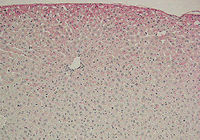
Immunohistochemical staining using anti-Dibromo-tyrosine, mAb (3A5).
anti-Dibromo-tyrosine [DiBrY], mAb (3A5)
JAI-MBY-020P
ApplicationsWestern Blot, ELISA, ImmunoHistoChemistry
Product group Antibodies
ReactivityAll Species, Human
Overview
- SupplierJaICA
- Product Nameanti-Dibromo-tyrosine [DiBrY], mAb (3A5)
- Delivery Days Customer10
- ApplicationsWestern Blot, ELISA, ImmunoHistoChemistry
- CertificationResearch Use Only
- ClonalityMonoclonal
- Clone ID3A5
- HostMouse
- IsotypeIgG1
- Scientific DescriptionMonoclonal Antibody. Recognizes dibromotyrosine (DiBrY), N-acetylated dichloro tyrosine (NAcDiClY), diiodo tyrosine (DiIY), N-bromosuccinimide-treated BSA, HOCl-treated BSA and dibromo-tyrosone conjugated BSA (halogene-modified tyrosine at both 3- and 5-position). Does not cross-react with dityrosine-conjugated BSA, peroxynitrite-treated BSA, tyrosine (Y), chrolotyrosine(ClY), 3-3-dityrosine (DiY), 3-aminotyrosine (NH2Y), 3-nitrotyrosine (NO2Y), phenylalanine (Phe), o-phosphotyrosine, 3,4-dihydroxyphenylacetic acid (DOPA) and 2-hydroxy-4-phenylacetic acid. Weakly cross-reacts with Bromotyrosine (BrY). Lyophilized. Contains 10mM PBS (pH7.4). Neutrophils and eosinophils play an important role in the defence system against microbial infection. Myeloperoxidase (MPO) and eosinophil peroxidase (EPO) are known to catalyze formation of hypochlorous acid (HOCl) and hypobromous acid (HOBr). These reactive intermediates may react with proteins, lipids and nucleotides, and it has been reported to form tyrosine halogenation such as dibromotyrosine (DiBrY). DiBrY is a Br-modified tyrosine at 3- and 5- position, which is one of the major oxidative products derived from neutrophil myeloperoxidase. DiBrY may be a novel biomarker for tissue damage which is related to inflammatory and allergic disorders. - Neutrophils and eosinophils play an important role in the defence system against microbial infection. Myeloperoxidase (MPO) and eosinophil peroxidase (EPO) are known to catalyze formation of hypochlorous acid (HOCl) and hypobromous acid (HOBr). These reactive intermediates may react with proteins, lipids and nucleotides, and it has been reported to form tyrosine halogenation such as dibromotyrosine (DiBrY). DiBrY is a Br-modified tyrosine at 3- and 5- position, which is one of the major oxidative products derived from neutrophil myeloperoxidase. DiBrY may be a novel biomarker for tissue damage which is related to inflammatory and allergic disorders.
- ReactivityAll Species, Human
- Storage Instruction-20°C,2°C to 8°C
- UNSPSC12352203
